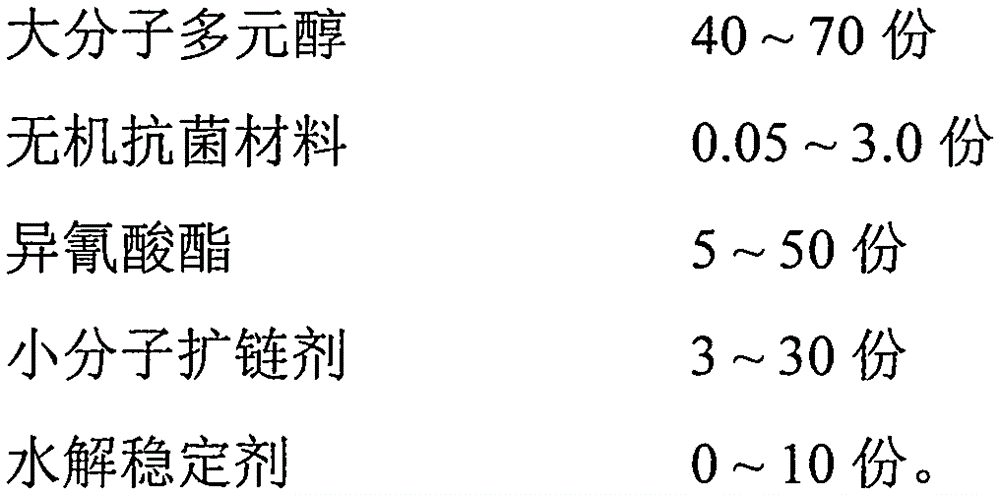Antibacterial thermoplastic polyurethane composite material and preparation method thereof
A technology of thermoplastic polyurethane and composite materials, applied in the field of antibacterial polymers, can solve the problems of organic antibacterial agents such as volatilization, poor chemical stability, and large environmental pollution, and achieve long-lasting antibacterial effects, low cost, and small environmental pollution.
- Summary
- Abstract
- Description
- Claims
- Application Information
AI Technical Summary
Problems solved by technology
Method used
Image
Examples
Embodiment 1
[0028] Weigh 50 parts of polytetrahydrofuran ether diol, 19 parts of 1,4-butanediol, and 4 parts of carbodiimide, and place them at 70° C. for 3 hours for melting and dehydration. Put polytetrahydrofuran ether diol, 1,4-butanediol and carbodiimide after melting and dehydration, and 30 parts of diphenylmethane diisocyanate melted at 80°C into a twin-screw reaction extruder for reaction, and extrude The temperature is 200°C. Add 1.2 parts of nano-silver in the middle of the twin-screw reaction extruder, and the mixture melt ("mixture melt" refers to tetrahydrofuran ether glycol, 1,4-butanediol, carbodiimide, diphenylmethane The mixture (melt) composed of isocyanate is melted and mixed thoroughly, and then pelletized under water to obtain thermoplastic polyurethane composite material particles. The obtained thermoplastic polyurethane composite material particles were dried in an oven at 150°C and aged for 20 hours to obtain the desired antibacterial thermoplastic polyurethane co...
Embodiment 2
[0031] Weigh 45 parts of polyethylene adipate diol, 21 parts of glycerol, and 1 part of bisphenol A diglycidyl ether, and place them at 90° C. for 4 hours for melting and dehydration. Add polyethylene adipate diol, glycerol, bisphenol A diglycidyl ether and 23 parts of toluene diisocyanate melted at 60°C to the twin-screw reaction extruder for reaction at the same time after melting and dehydration. The outlet temperature was 180°C. Add 2 parts of TiO in the middle of the twin-screw reaction extruder 2 , melted and fully mixed with the mixture, and pelletized under water to obtain thermoplastic polyurethane composite material particles. The obtained thermoplastic polyurethane composite material particles were placed in an oven at 130° C. for drying and aging for 40 hours to obtain the desired antibacterial thermoplastic polyurethane composite material.
[0032] The tensile strength of the obtained antibacterial thermoplastic polyurethane is 32.2MPa, and the elongation at bre...
Embodiment 3
[0034] Weigh 60 parts of polyoxypropylene glycol, 25 parts of triisopropanolamine, and 9 parts of 2-oxazoline, and place them at 110° C. for melting and dehydration for 2 hours. Add polyoxypropylene diol, isopropanolamine and 2-oxazoline after melting and dehydration, and 44 parts of p-phenylene diisocyanate melted at 100°C to the twin-screw reaction extruder for reaction at the same time, and the extrusion temperature is 210 ℃. Add 2.7 parts of nano-ZnO in the middle section of the twin-screw reaction extruder, melt and fully mix with the mixture, and pelletize under water to obtain thermoplastic polyurethane composite material particles. The obtained thermoplastic polyurethane composite material particles were dried and aged in an oven at 200° C. for 64 hours to obtain the required antibacterial thermoplastic polyurethane composite material.
[0035] The obtained antimicrobial thermoplastic polyurethane has a tensile strength of 29 MPa and an elongation at break of 592%. The ...
PUM
| Property | Measurement | Unit |
|---|---|---|
| Tensile strength | aaaaa | aaaaa |
| Tensile strength | aaaaa | aaaaa |
| Tensile strength | aaaaa | aaaaa |
Abstract
Description
Claims
Application Information
 Login to View More
Login to View More - R&D
- Intellectual Property
- Life Sciences
- Materials
- Tech Scout
- Unparalleled Data Quality
- Higher Quality Content
- 60% Fewer Hallucinations
Browse by: Latest US Patents, China's latest patents, Technical Efficacy Thesaurus, Application Domain, Technology Topic, Popular Technical Reports.
© 2025 PatSnap. All rights reserved.Legal|Privacy policy|Modern Slavery Act Transparency Statement|Sitemap|About US| Contact US: help@patsnap.com



